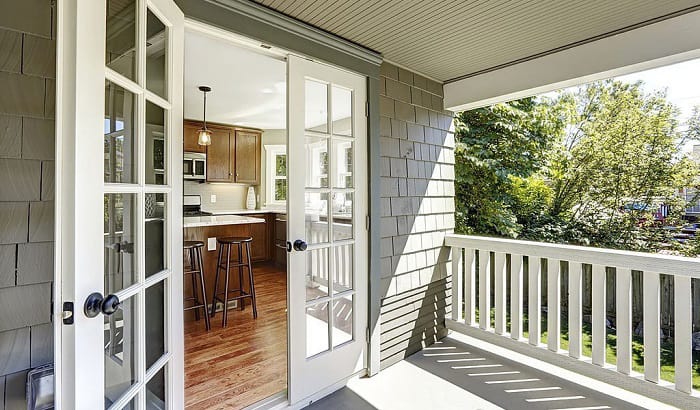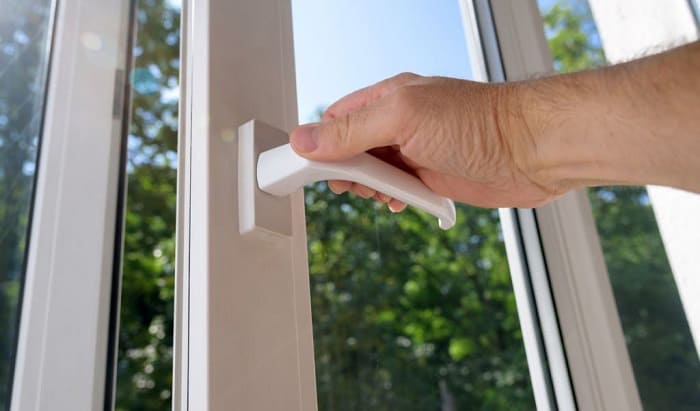Outward swinging doors are the go-to choice of families living in hurricane-prone areas as they are weather-resistant, easier to use, and hard to force open.
Outwardly opening doors may appear to be secured, but they have specific key weaknesses that might serve as easy entry points for break-ins. Fortunately, if you can identify its weak spots, you can address any outward opening door security issues quickly and easily.
If you have doors that open outward, following this guide can help you secure them. Read on and learn how to secure a door that opens outward.
Table of Contents
3 Easy Ways to Secure a Door That Opens Outward
1. Secure Outward Opening Door Hinges
Intruders are drawn to exposed hinges with removable pins. Start by replacing unsecured hinges with the following.
- Non-removable hinge pins: Hinges with pins having a flat, crimped end, and rivets preventing the pin from moving or popping out. Also called crimped pin hinges or fast-riveted hinges.
- Security stud hinges: Similar to ordinary hinges, except that they have built-in studs on one side that fits into a hole on the other side, keeping the door from being moved from the frame and off the hinge.
- Door hinge security pin or hinge protector: Similar to stud security hinges, only you do not need to remove your current hinges. Just drill and put a protruding set screw or steel rod to hold the pin in place.
- Set screw hinges: A set screw, which is inaccessible when the door is closed, secures the pin on the hinge.
When you replace your outward opening door hinges, pick the kind that matches the size and hole pattern of your original hinges, ensuring that the new hinges fit perfectly into the slots of the old hinge.
2. Secure Outward Swinging Door Security Lock With a Latch Guard
A common flaw of outward swinging doors is that there is typically a gap between the frame and the door, exposing the bolt or latch from the outside.
Most locking mechanisms can be bypassed by experienced intruders when they have access to the bolt or latch.
A latch guard is a plate that conceals the gap between the jamb and the door, and prevents external access to the latch. This thin metal plate can be installed onto your door with two through-bolts.
You can either install them on right or left-facing, allowing easier opening from one side.
It is worth noting that latch guards are usable for a single-handle door and deadlock for outward opening door. However, it is not usable for outward swinging doors featuring knob and deadbolt.
Barricade a door that opens out
Door barricades are becoming popular for their durability as they can withstand about 1,100 pounds of force (depending on the unit), offering security for doors that open out.
A barricade for out-swinging doors consists of three parts – a door plate, a floor plate, and a locking handle.
Installation won’t take much time. You just have to screw the plates to the door near the bottom, on the floor, and slide the locking handle in its place to secure the door.
When installing a barricade, you have to take into consideration that the drop to the floor plate can be as much as 3/4 inches thick, so the placement and distance between the ground and the bottom of the door must be factored in.
There is also a version of this type of lock that does not require drilling into the floor for those who are uneasy with drilling into the floor.
3. Use a Security Bar to Secure French Doors That Open Out
Placing a horizontal security bar inside is another simple alternative to lock a door that opens outward. When an intruder tries to pull the door open, the bar prevents the door from opening.
Security bars are pretty common nowadays. Unfortunately, there aren’t many security bars explicitly designed for outward opening doors on the market.
Alternatively, you can make one for yourself using a metal bar, a solid wooden bar, or even a broomstick that is longer than the width of your door, a rope, and duct tape.
- Position the broomstick or bar across the door frame, slightly above the level of the doorknob.
- Fasten the broomstick or bar to the door frame using duct tape.
- Knot or loop the rope around the bar or the broomstick handle, and tie it to the doorknob in a figure-8 pattern to securely bind the stick and doorknob.
This solution may be temporary; a handy option for those needing a quick fix, as the issue with this entirely DIY solution is that the tape may get loose and slip off over time.
Thus, you may opt to buy a security bar or construct bracing support to hold the DIY bar securely in place.
Helpful Tips You Should Know
- Use security film to protect the door if you install one made of glass. Intruders can still be able to enter your home by breaking the glass. That’s why it’s also a great idea to secure the glass. The easiest method is to apply a security window film.
On impact, the film will bind with the glass and offer extra security by keeping the glass pieces together in a sheet, something an intruder would find difficult and frustrating to penetrate.
- Attach the door with a heavy object or heavy furniture. This may be practically free and a practical option. You only need a rope, a cord, a chain, or a belt; use any of these to secure the door handles to any furniture that is too heavy to move or broader than your outward opening door.
You must ensure that the furniture is either very close to the door or too heavy to move and unlikely to trip; otherwise, the door may still be unlocked if the cord is too long, and the intruder can move the furniture all through the doorway.
Another thing to consider is that this method may damage the furniture if it is pushed across the floor and crashes against it. It may also cause damage to your walls or other furnishings as the area becomes disordered.
Conclusion
There may not be as many options on the market for outward opening doors as there are for inward opening doors. But no matter what direction the door swings, at the bare minimum, you must make it increasingly challenging than it is worth for an intruder to move on to the next household.
We have outlined options for folks wondering how to secure a door that opens outward. These are simple methods and may be accomplished without breaking the bank, thus, making your door far more secure and resistant to forced entry attempts.

I am the last member to join Revolar and might be just the luckiest to work with dedicated people like Teddy and John. Our team has established a process where my only job is writing the best content to deliver incredible ideas and guides.





